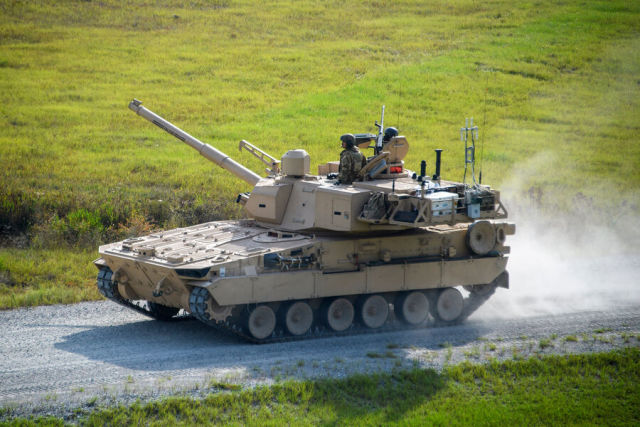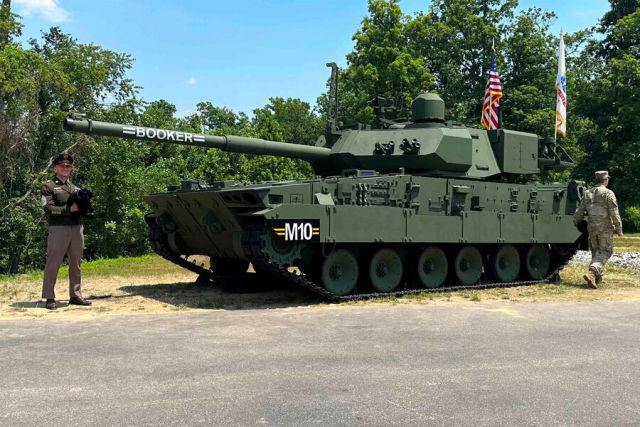NI: The United States has presented the weapons of the future for the war with Russia and China
The US army is preparing for the "next big war" - it wants to move away from counterinsurgency tactics and be ready for large-scale battles with opponents such as China and Russia. To do this, new light tanks, infantry fighting vehicles and combat robotic vehicles will be introduced into the American army, writes The National Interest magazine. What kind of weapon is this and why the newest American tank would not have withstood the battle of Avdiivka - in the material of the military observer "Gazeta.En" by Mikhail Khodarenka.
From counterinsurgency to large-scale battles
In 2023, the US Army Ground Forces adopted 24 new types of weapons and military equipment. Similar progress is expected in 2024. At the same time, the United States places special hopes on three promising platforms.
These, according to The National Interest magazine, include the M10 Booker armored infantry support vehicle, the XM30 infantry fighting vehicle, designed to replace the aging M2 Bradley IFV, and the Robotic Combat Vehicle (RCV).
According to NI, the Ground forces of the US Armed Forces are currently undergoing significant modernization in order to
This shift, The National Interest emphasizes, marks a drastic departure from two decades of counterinsurgency operations.
In addition, the US Army Ground Forces are exploring increasing combat capabilities with the help of robotic combat vehicles, seeking to improve situational awareness and tactical capabilities.
More than 20 years of fighting in the Middle East against terrorist groups and insurgent movements have formed a special mindset in the US military, according to which non-traditional threats such as improvised explosive devices (IEDs) were at the top of the list of all possible dangers for the American army. However, times have changed, and large-scale conventional warfare with almost equally capable adversaries such as China and Russia is back on the agenda.
Promising ground combat systems
First of all, The National Interest pays attention to the M10 Booker. It is an armored infantry support vehicle designed to pave the way for mechanized units with their firepower and mobility.
The armored personnel carrier is equipped with a 105 mm M35 cannon, a 12.7 mm M2 Browning heavy machine gun and a 7.62 mm light machine gun. It is also adapted for fighting in urban environments.

Image source: US Army
Weighing about 40 tons, the M10 Booker can reach a top speed of 45 mph (72.4 km/h) and cover a distance of 350 miles (563 km) without refueling. The crew consists of four people. The new combat vehicle has a modular design that can incorporate new technologies into the M10 as they develop.
The US Army has signed a contract with General Dynamics Land Systems for the supply of 26 M10 Booker combat vehicles with the possibility of purchasing another 70 at the initial stage of production.
The next ground-based system to pay attention to, according to The National Interest magazine, is the XM30 infantry fighting vehicle. Still under development, the XM30 is a replacement for the M2 Bradley BMP, which has been in service with the US Army for more than 40 years.
As for weapons, the XM30 is likely to have a cannon, a light machine gun and anti-tank missiles. For prototypes of the combat vehicle, the US Armed Forces requested a 50-mm main gun in an uninhabited combat module and anti-tank missiles. The basic performance requirements also provide for a two-man crew and a compartment for six fully equipped infantrymen.
Like the M10 Booker and many other advanced weapons systems, the XM30 will have a modular design. The XM30's open architecture will allow new technologies to be introduced into the promising BMP as they develop, providing an overwhelming advantage in the fight against any potential enemy, according to the US army.
Last year, the US Army selected Rheinmetall Vehicles and General Dynamics Land Systems as finalists out of five applicants for the supply of the XM30. The two companies now have a $1.6 billion contract to supply XM30 BMP prototypes by the end of 2024.
The future of UAVs
Among other things, the US Army is showing great interest in the development of robotic combat vehicles (RCV) - unmanned ground systems. According to ideologists, a modular and lightweight vehicle will provide fire support and reconnaissance capabilities.
The United States believes that RCV-Light will provide increased situational awareness, lethality and tactical capabilities for Ground Forces formations during multi-domain operations. Operators of such machines will remotely control RCVS or instruct them to operate semi-autonomously. RCV variants can serve as reconnaissance vehicles or accompany manned combat vehicles.
The combat robotic vehicle is still under development. In September 2023, the US Army signed contracts with four companies to develop a prototype by August 2024. In addition to its combat systems, the RCV will require powerful electronic warfare capabilities to ensure that it can operate in the face of powerful enemy electronic countermeasures.
Unmanned systems are not just the future of war, The National Interest emphasizes, they already play a big role in it, as the experience of fighting in Ukraine shows, where both sides of the conflict use unmanned aerial vehicles by the hundreds every day.
As a conclusion, we can say the following. The adoption of the three platforms listed above by the Ground Forces of the US Armed Forces will certainly increase the combat capabilities of the American infantry. But to reduce the entire preparation of the United States for new major wars to just three models of armored vehicles would be too simplistic a view.
And it cannot be said that armored combat vehicles manufactured by the United States during the high-intensity conflict in Ukraine showed their best side or remained unsurpassed on the battlefield.
Armored combat vehicles will certainly play a significant role in the wars of the future. But while the problem of fighting drones and barrage ammunition has not been fundamentally solved, while the cutting edge of modern armed confrontation is buzzing like a hive from drone engines, even the most promising armored combat vehicles can only be used as mobile firing points at a considerable distance from the line of contact. Otherwise, even the most promising tanks and infantry fighting vehicles will be lost in the first minutes of the battle.
The opinion of the author may not coincide with the position of the editorial board.
Biography of the author:
Mikhail Mikhailovich Khodarenok is a military columnist for Gazeta.Ru", retired colonel.
He graduated from the Minsk Higher Engineering Anti-Aircraft Missile School (1976), the Military Air Defense Command Academy (1986).
Commander of the S-75 anti-aircraft missile division (1980-1983).
Deputy commander of the anti-aircraft missile regiment (1986-1988).
Senior Officer of the General Staff of the Air Defense Forces (1988-1992).
Officer of the Main Operational Directorate of the General Staff (1992-2000).
Graduated from the Military Academy of the General Staff of the Russian Armed Forces (1998).
Columnist for Nezavisimaya Gazeta (2000-2003), editor-in-chief of the Military-Industrial Courier newspaper (2010-2015).
Mikhail Khodarenok


